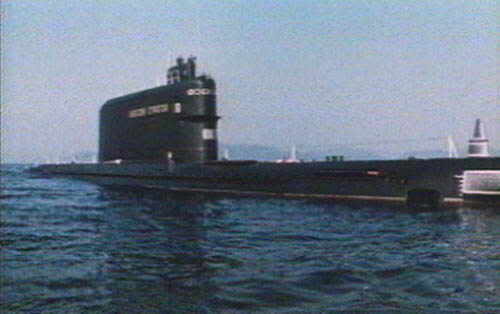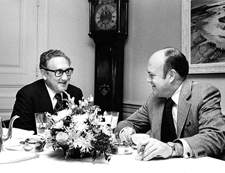09 January 2010
Sea Story

(Red Banner Pacific Ocean Fleet Golf-class Ballistic Missile Submarine K-129)
Oh Lord, this is a complicated business. I wish I could just ask Rex a couple questions when I had the chance, but we were working on other things and I never got around to it.
My pal Mac says he had dinner with Rex and Admiral Zumwalt in Saigon in December 1969- I mis-typed yesterday, being focused on 1970- since his impeccable records have his travel claim for that trip and the memo ordering him to report as Chief of Staff of the Defense Intelligence Agency in early January 1970.
Our alert reader base swung into swift and decisive action. Rex According to Larry Berman, Rex was, as he reports himself in his short biography, on the CINCPACFLT Staff of Admiral Ulysses Grant Sharp in 1966, departing for the Republic of Vietnam in May of 1968 and returning to the continental United States in June of 1969.
I trust Mac’s memory and his impeccable documentation, so his presence in Vietnam in December of 1969 is a mystery to me. Rex had been properly relieved by CAPT Bob Pyle; I have his phone number around somewhere. I suppose the answer is to call him up and see if Rex made a trip back to the war he did so much to mold.
But as I have said before, the world never allows you to concentrate on one thing, and I have other fish to fry this morning. Same thing in the business. After a relentless focus on infiltration routes and Cambodian sanctuaries, Rex had to concentrate on events elsewhere in the Pacific as he settled back into life Stateside.
The month before Rex reported to lovely Hawaii, something big was happening in the Mid-PAC, something that he would never be able to talk about. That may have been one of the reasons that the quest to honor Jack Graf meant so much to him. The events of a lost war were all out there, and with the passage of time, nearly everyone who had something to say about the War, and Jack’s part of it has done so.
Rex wanted us to remember the sacrifice of a generation through the lens of one man. He knew how rapidly and intentionally we forget other things.
A similar effort is happening right now. It is about something else, an operation that in its way was as expensive, complex and technically innovative as the Moon Shot. Rex would wind up in the middle of it as the Director of Naval Intelligence. It was nothing he could talk about, and in all the years after, he never did.
I have to say something right here. Everything from this sentence- call it a tear line, like we used to in the business- is from open source, readily available information. I do not endorse, vouch for accuracy, have any personal knowledge of, nor involvement in the matter. How is that for a disclaimer?
Think of it as a sea story, if you will.
You know the difference between a sea story and a fairy tale don’t you? A sea story starts out “This is a no-shitter….”
So, this is no shit. Really happened. Maybe.
The development of the Sound Surveillance System (SOSUS) added important new capabilities to U.S. Navy efforts to identify and locate Soviet submarines armed with strategic nuclear missiles. The Navy Scientific and Technical Intelligence Center (NAVSTIC) was established in 1968 to integrate information harvested from the world ocean with that collected by the Naval Field Operational Intelligence Office at Fort Meade.
High-speed dedicated communications lines connected Suitland, the Pentagon and the Altantic and Pacific Fleet intelligence centers, and had been in place through the ONI ADP Center at Arlington Hall Station, right across the street from my residence today at Big Pink.
The goal was lofty. Naval Intelligence intended to track every unit of interest on the world ocean, and particularly the highest value units of them all: the Soviet boomers.
In April 1968, some highly unusual activity was noted in the mid-Pacific. Soviet Red Banner Pacific Fleet surface and air aircraft were observed conducting a “surge deployment” which is one of the most intense analytic challenges that exist in the ocean surveillance business, dispersal can be the only indicator of impending hostilities.
This one did not appear strategic in nature, but involved in unusual operations in the North Pacific. Analysts in Suitland, Maryland, and Pearl Harbor poured over the information. SOSUS was tasked with an exhaustive review of the sonograms covering the period. NavFac Point Sur, south of lovely Monterey, was able to isolate a sonic low-frequency event at midnight on March 8, 1968. Using that time as datum, five line-of-bearing hits were able to identify a likely area northeast of Hawaii for a highly unusual event.
It was the loss of Golf-class ballistic missile submarine K-129 with all hands, and three nuclear-tipped SS-N-5 Serb missiles.
Despite week of intense effort, the Soviets were unable to locate the wreck, and activity levels returned to normal levels. The Bear was nervous about what they had lost but there was not a damned thing they could do about it.
It was time for the Navy to check things out. The former Regulus cruise missile submarine USS Halibut (SSGN-587) from Pearl Harbor to search the likely area of the disaster in the Soviet diesel patrol box. Halibut almost miraculously located the wreck after only three weeks. Thousands of detailed pictures of the wreck were acquired, analyzed and packaged by Naval Intelligence analysts.
To say that the highly classified material was electrifying is an understatement. The latest technology of the Main Enemy was strewn across the ocean floor, right there for the taking.
Lyndon Johnson signed out at Presidential Unit Commendation in recognition of the accomplishment, the public version of which was carefully worded to disclose nothing.

(National Security Advisor Henry Kissinger, left, and SECDEF Melvin Laird)
In 1970, based on the imagery, SECDEF Melvin Laird and National Security Advisor Henry Kissinger talked about what a trove of information was lying there, three miles down on the ocean floor. Nuclear weapons. Rocket technology. Code books.
No salvage activity had ever been conducted in water that deep. It would be an undertaking as profound as launching Sputnik, only completely secret. The reward was to possibly get right inside the Soviet war machine. They devised a covert plan to recover the wreckage, which was accepted by President Nixon, just as Rex was getting ready to take over the Office of Naval Intelligence.
The CIA was tasked to attempt the recovery, but of course they had to use the expertise of the Navy, and Naval Intelligence was in the middle of the whole thing.
The press talks about it as Project Jennifer, but that is not what it was. You can find out easily enough, if you care to look. I am not going to touch that one with a three-mile long pole.
That is a no-shitter.
Copyright 2010 Vic Socotra
www.vicsocotra.com
Subscribe to the RSS feed!